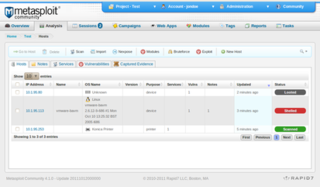An exploit is a method or piece of code that takes advantage of vulnerabilities in software, applications, networks, operating systems, or hardware, typically for malicious purposes. The term "exploit" derives from the English verb "to exploit," meaning "to use something to one’s own advantage." Exploits are designed to identify flaws, bypass security measures, gain unauthorized access to systems, take control of systems, install malware, or steal sensitive data. While an exploit by itself may not be a malware, it serves as a vehicle for delivering malicious software by breaching security controls.
A penetration test, colloquially known as a pentest, is an authorized simulated cyberattack on a computer system, performed to evaluate the security of the system; this is not to be confused with a vulnerability assessment. The test is performed to identify weaknesses, including the potential for unauthorized parties to gain access to the system's features and data, as well as strengths, enabling a full risk assessment to be completed.

In programming and software development, fuzzing or fuzz testing is an automated software testing technique that involves providing invalid, unexpected, or random data as inputs to a computer program. The program is then monitored for exceptions such as crashes, failing built-in code assertions, or potential memory leaks. Typically, fuzzers are used to test programs that take structured inputs. This structure is specified, e.g., in a file format or protocol and distinguishes valid from invalid input. An effective fuzzer generates semi-valid inputs that are "valid enough" in that they are not directly rejected by the parser, but do create unexpected behaviors deeper in the program and are "invalid enough" to expose corner cases that have not been properly dealt with.
A security hacker or security researcher is someone who explores methods for breaching defenses and exploiting weaknesses in a computer system or network. Hackers may be motivated by a multitude of reasons, such as profit, protest, information gathering, challenge, recreation, or evaluation of a system weaknesses to assist in formulating defenses against potential hackers.
Watering hole is a computer attack strategy in which an attacker guesses or observes which websites an organization often uses and infects one or more of them with malware. Eventually, some member of the targeted group will become infected. Hacks looking for specific information may only attack users coming from a specific IP address. This also makes the hacks harder to detect and research. The name is derived from predators in the natural world, who wait for an opportunity to attack their prey near watering holes.

The Metasploit Project is a computer security project that provides information about security vulnerabilities and aids in penetration testing and IDS signature development. It is owned by Boston, Massachusetts-based security company, Rapid7.

BackTrack was a Linux distribution that focused on security, based on the Knoppix Linux distribution aimed at digital forensics and penetration testing use. In March 2013, the Offensive Security team rebuilt BackTrack around the Debian distribution and released it under the name Kali Linux.
A month of bugs is a strategy used by security researchers to draw attention to the lax security procedures of commercial software corporations.
webarchive is a Web archive file format available on macOS and Windows for saving and reviewing complete web pages using the Safari web browser. The webarchive format differs from a standalone HTML file because it also saves linked files such as images, CSS, and JavaScript. The webarchive format is a concatenation of source files with filenames saved in the binary plist format using NSKeyedArchiver. Support for webarchive documents was added in Safari 4 Beta on Windows and is included in subsequent versions. Safari in iOS 13 has support for web archive files. Previously there was a third party iOS app called Web Archive Viewer that provided this functionality.
Pwn2Own is a computer hacking contest held annually at the CanSecWest security conference. First held in April 2007 in Vancouver, the contest is now held twice a year, most recently in March 2024. Contestants are challenged to exploit widely used software and mobile devices with previously unknown vulnerabilities. Winners of the contest receive the device that they exploited and a cash prize. The Pwn2Own contest serves to demonstrate the vulnerability of devices and software in widespread use while also providing a checkpoint on the progress made in security since the previous year.

w3af is an open-source web application security scanner. The project provides a vulnerability scanner and exploitation tool for Web applications. It provides information about security vulnerabilities for use in penetration testing engagements. The scanner offers a graphical user interface and a command-line interface.
WarVOX was a free, open-source VOIP-based war dialing tool for exploring, classifying, and auditing phone systems. WarVOX processed audio from each call by using signal processing techniques and without the need of modems. WarVOX used VoIP providers over the Internet instead of modems used by other war dialers. It compared the pauses between words to identify numbers using particular voicemail systems.
The Java software platform provides a number of features designed for improving the security of Java applications. This includes enforcing runtime constraints through the use of the Java Virtual Machine (JVM), a security manager that sandboxes untrusted code from the rest of the operating system, and a suite of security APIs that Java developers can utilise. Despite this, criticism has been directed at the programming language, and Oracle, due to an increase in malicious programs that revealed security vulnerabilities in the JVM, which were subsequently not properly addressed by Oracle in a timely manner.
A bug bounty program is a deal offered by many websites, organizations, and software developers by which individuals can receive recognition and compensation for reporting bugs, especially those pertaining to security exploits and vulnerabilities.

Heartbleed is a security bug in some outdated versions of the OpenSSL cryptography library, which is a widely used implementation of the Transport Layer Security (TLS) protocol. It was introduced into the software in 2012 and publicly disclosed in April 2014. Heartbleed could be exploited regardless of whether the vulnerable OpenSSL instance is running as a TLS server or client. It resulted from improper input validation in the implementation of the TLS heartbeat extension. Thus, the bug's name derived from heartbeat. The vulnerability was classified as a buffer over-read, a situation where more data can be read than should be allowed.
Project Zero is a team of security analysts employed by Google tasked with finding zero-day vulnerabilities. It was announced on 15 July 2014.

Stagefright is the name given to a group of software bugs that affect versions from 2.2 "Froyo" up until 5.1.1 "Lollipop" of the Android operating system exposing an estimated 950 million devices at the time. The name is taken from the affected library, which among other things, is used to unpack MMS messages. Exploitation of the bug allows an attacker to perform arbitrary operations on the victim's device through remote code execution and privilege escalation. Security researchers demonstrate the bugs with a proof of concept that sends specially crafted MMS messages to the victim device and in most cases requires no end-user actions upon message reception to succeed—the user doesn't have to do anything to 'accept' exploits using the bug; it happens in the background. A phone number is the only information needed to carry out the attack.
EternalBlue is a computer exploit software developed by the U.S. National Security Agency (NSA). It is based on a vulnerability in Microsoft Windows that allowed users to gain access to any number of computers connected to a network. The NSA knew about this vulnerability but did not disclose it to Microsoft for several years, since they planned to use it as a defense mechanism against cyber attacks. In 2017, the NSA discovered that the software was stolen by a group of hackers known as the Shadow Brokers. Microsoft was informed of this and released security updates in March 2017 patching the vulnerability. While this was happening, the hacker group attempted to auction off the software, but did not succeed in finding a buyer. EternalBlue was then publicly released on April 14, 2017.

Rafay Baloch is a Pakistani ethical hacker and security researcher. He has been featured and known by both national and international media and publications like Forbes, BBC, The Wall Street Journal, The Express Tribune and TechCrunch. He has been listed among the "Top 5 Ethical Hackers of 2014" by CheckMarx. Subsequently he was listed as one of "The 15 Most Successful Ethical Hackers WorldWide" and among "Top 25 Threat Seekers" by SCmagazine. Baloch has also been added in TechJuice 25 under 25 list for the year 2016 and got 13th rank in the list of high achievers. Reflectiz, a cyber security company, released the list of "Top-21 Cybersecurity Experts You Must Follow on Twitter in 2021" recognizing Rafay Baloch as the top influencer. On 23 March 2022, ISPR recognized Rafay Baloch's contribution in the field of Cyber Security with Pride for Pakistan award. In 2021, Islamabad High court designated Rafay Baloch as an amicus curia for a case concerning social media regulations.
Log4Shell (CVE-2021-44228) is a zero-day vulnerability in Log4j, a popular Java logging framework, involving arbitrary code execution. The vulnerability had existed unnoticed since 2013 and was privately disclosed to the Apache Software Foundation, of which Log4j is a project, by Chen Zhaojun of Alibaba Cloud's security team on 24 November 2021. Before an official CVE identifier was made available on 10 December 2021, the vulnerability circulated with the name "Log4Shell", given by Free Wortley of the LunaSec team, which was initially used to track the issue online. Apache gave Log4Shell a CVSS severity rating of 10, the highest available score. The exploit was simple to execute and is estimated to have had the potential to affect hundreds of millions of devices.







